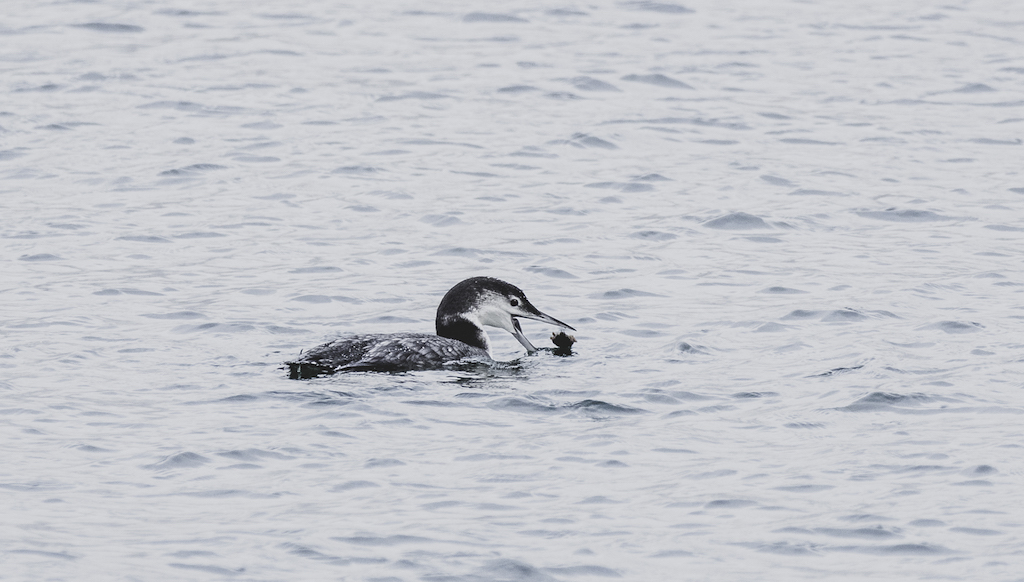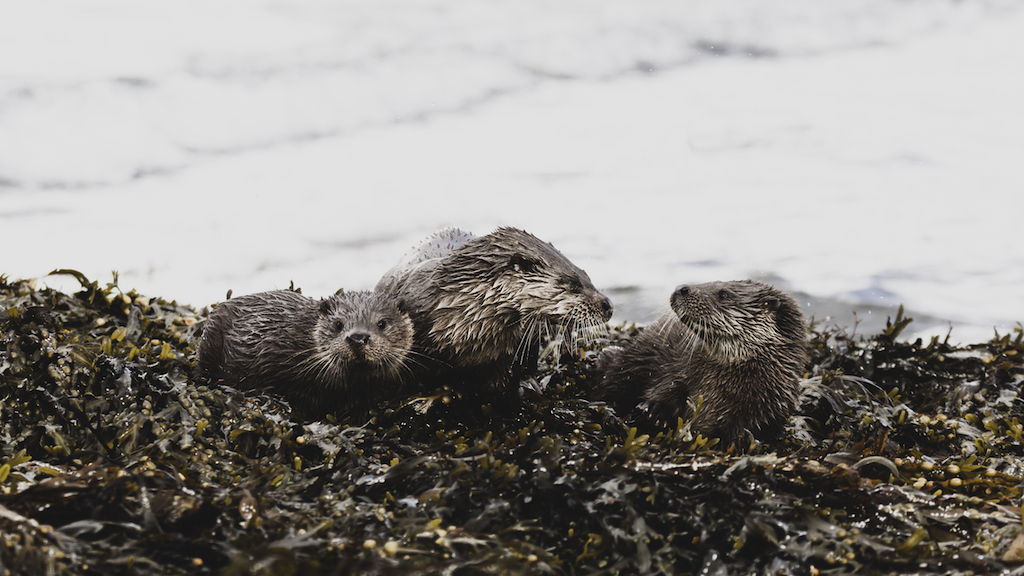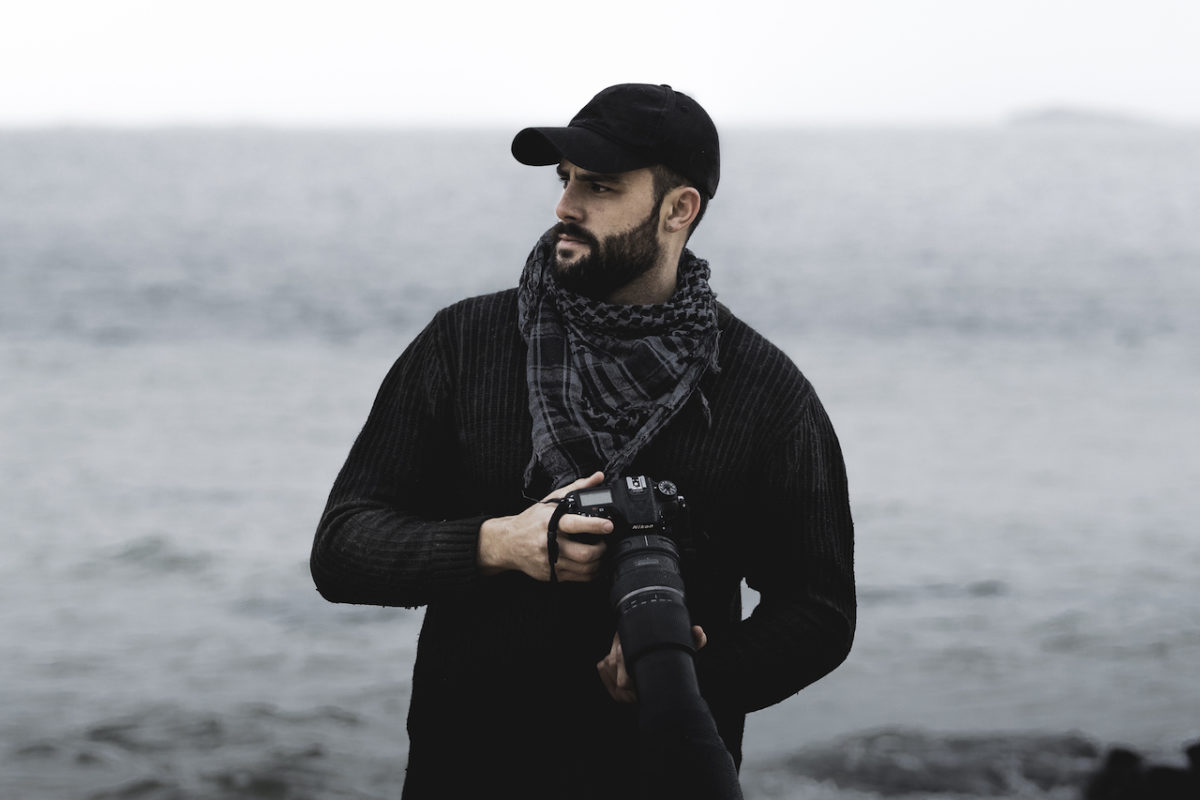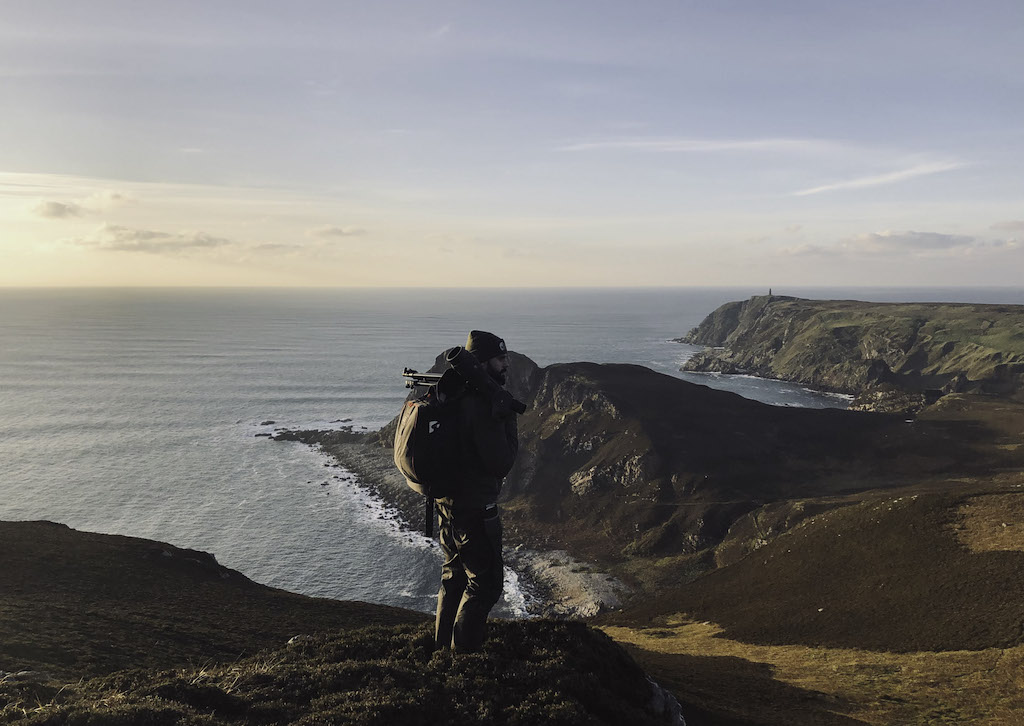By David Dinsley
David Dinsley, a naturalist and conservationist, shares his wildlife adventures on the Isle of Islay, Scotland or as locals know it – Queen of the Hebrides. Dinsley is the warden of The Oa reserve, a 2,100-hectare nature reserve and working farm owned by the RSPB (Royal Society for the Protection of Birds).
The winter sun sits low in the January sky. A bright beam illuminates the sea before me, and a crisp intermittent breeze can be felt, reminding me it isn’t spring yet. In the water below, an otter moves through the glare, skirting the rock edge, where land meets water. With smooth and slinking movements, it soon vanishes out of sight.
To my left the haunting call of a great northern diver echoes across a small coastal bay, reminiscent of the wailing from an eerie spirit. The diver sits tight to the surface, peering its head under for a quick glimpse below. I watch as it sinks under surface, looking for molluscs and fish in the waters below. It does this time and time again. Occasionally, it brings something to the surface, in this case a crab. It removes the crab’s legs and pincers from the carapace, before swallowing it whole.

In front of me, harbour seals lounge and loll on the rocks above the gentle lapping tide, snorting and whining when the urge strikes them. Drifting past the seals arrives a raft of sea ducks, these are red-breasted mergansers. Like the diver, they submerge below the surface looking for fish and seizing them within their serrated bills. They quickly catch and swallow the fish once they return to the water’s surface. But they aren’t alone. Opportunistic herring gulls follow them and pillage them of their catch.
My feet are getting chilly. Wearing wellies and sitting still in a portable hide, winter’s cool grip is slowly sinking in. I’ve been in here for hours; watching, waiting, and observing. No sign of my query yet though, the camera is primed and ready for when and if the moment arises.
I’m here for eagles. White-tailed eagles.

Life finds me on the Isle of Islay – Queen of the Hebrides. I am the warden of The Oa reserve, a 2,100-hectare nature reserve and working farm owned by the RSPB (Royal Society for the Protection of Birds). I’ll be honest, I can’t believe I’m here. I have a huge sense of imposter syndrome that follows me around like the devil on my back and a lead weight in my boots.
Scotland, to me, was always ‘the dream.’ To live and to work on the west coast had long been an aspiration of mine, and for the longest time I never knew quite how to even achieve that. This place has forever held an allure and fascination in my heart. The friendly nature of the island communities, the rugged landscapes, beautiful coastlines, stunning waters and the jewel at the beating heart of it all, the wildlife. The amazing wildlife.
You really don’t have to travel to far off foreign lands for some spectacular species and remarkable encounters. In my opinion, Scotland’s wildlife is the absolute apex and upper echelon of British nature. From the mighty golden eagle and the majestic red deer, to the mysterious basking shark and charming otter.

So here I am. Living and working on the west coast of Scotland in a dream job role. I feel content, even blessed. But let me assure you – things weren’t always this way.
My school life never really amounted to much, and I left with little more then I took with me to begin with. I didn’t go on to higher education and my early working life was sloppy at best.
Much of this was due to my disinterest in the work I was doing. Put simply, I was just going through the motions. Living day to day, week to week, pay packet to pay packet. I worked in factories, shops, warehouses, a vehicle refurbishment garage and even a castle.
Don’t get me wrong, some of these jobs weren’t terrible, and I met some interesting folk within them. They certainly brought me out of my shell and forced me to live beyond the boundary of my comfort zone. I appreciated all of that, but I was unsettled and uninspired.
My dilemma was, I never knew how to channel my interest and passion for nature into a paying job.
Wildlife and nature had always been a part of my growing up. It may have waned a tad during my formative late teenage years; but it was always there in the background. I remember my childhood with a great fondness. My grandad Bill would often take me and my younger sister rock pooling around the tidal pools of Rocky Island, in the small suburban village of Seaton Sluice. One of those true gems of a memory that stays with you forever, imprinting on your future.
You couldn’t imagine the unbridled excitement I felt when I netted my first ever great crested newt, it was like an out of body experience. Naturally, this was before I knew they were a protected species and fear not, the newt was fine. On reflection it was a simpler naiver time. I wasn’t aware of environmental regulations, wildlife crime, the shocking rate of habitat and species loss – I could just enjoy nature for what it was, a pure joy.
Daily, I would fill my school bag with bird books, reading them during my break times. Back at home I would make my own books, doodling fact files for each species and getting lost in the natural world.
These memories were a far cry from my later years of unsatisfying jobs and an uncertain future. So I began to get the ball rolling; I created a birdwatching blog, started a nature specific Twitter account and Facebook page, and began volunteering with the National Trust, assisting in practical work on a local estate.

In 2014, the opportunity I needed appeared. A paid traineeship with Durham Wildlife Trust. I applied, and amazingly, I got it. There were six of us in the team and over the next ten months, funded by the National Heritage Lottery, we were given all the basic skills and training for habitat control, wildlife surveys and ground management works.
Upon finishing my traineeship, I landed my next gig with the RSPB, conducting overnight nest watches on breeding hen harrier in the Forest of Bowland AONB. My next stop was North Tyneside Council, managing green spaces, and from there I landed my biggest job to date.
In October 2015 I became the reserve warden for WWT (Wildfowl & Wetlands Trust) Washington, where I stayed for just under half a decade. This was a really special and formative time for me both personally and professionally. I made some special connections and learnt some invaluable lessons. I remember thinking to myself on many occasions, “wow, I’m getting paid to do this.”
This job also provided me with my first taste of international conservation work, catching and ringing Bewick’s Swans in Siberia as part of their long-term study by WWT.
During my career renaissance I also discovered my passion for wildlife photography. It creates a gateway to pure mental escapism for me, I can clear my mind and focus on the relationship between my eye, the camera and the subject. Nothing else matters in that split-second before I hit the shutter, capturing a moment in time. A fine example of this kind of electricity was when I locked eyes with a female Sparrowhawk – she stared with lightning yellow eyes straight down the barrel of the lens. Superb.
I’m never truly satisfied with the images I take, and I find myself always chasing the perfect image. This carrot on the stick is no doubt the compulsion that whets my appetite to carry on. Let’s be honest, if it was easy to achieve the perfect image, it would be a dull endeavour and over before it started.
As happy as I was – finally working in the career field I had hoped for and loving every minute – new opportunities dared me to dream even bigger. The time had come to take my next step, to continue to grow within my career. I had several interviews at the beginning of 2020 and then, things changed.
In April 2020 I, like many others in the UK, found myself furloughed during the first Covid-19 lockdown. The Coronavirus pandemic spread across the planet and threw our perceived normality off its axis. Travel and movements were restricted, traffic dried up, and my hometown of Whitley Bay felt like a ghost town.
Ordinarily my job would see me working outdoors five days a week on a nature reserve, but this new situation felt restrictive to say the least. I took to playing more guitar, editing old wildlife photographs, and watching Tiger King. But after just a few weeks I began to feel like a budgie in a cage. I should be outside; I’m not used to this much confinement.
However, lockdown presented me an opportunity, one I had previously glossed over for the bigger, more exciting adventures further afield. An opportunity to explore the coastal wilderness right on my doorstep. Living just off the seafront promenade, I could utilise that setting for my daily exercise and in doing so, suddenly a blank canvas was thrust my way and my small lockdown world opened up.
On blazing bright, warm spring mornings, the North Sea’s tidal drawl provided a constant back and forth soundtrack. Oystercatchers flocked just above the crashing waves. Starlings chattered, herring gulls surveyed the world from the chimney stacks above, and dog walkers and joggers went about their way.
My focus became the northern fulmars that adorned the small cliff face of the promenade, their ghostly grey shapes dressing the rockface like wayward ghouls, previously lost to the depths of the cold North Sea. With dark and dull eyes, they watched from above and their guttural cackles echoed out from the small caves and alcoves. In the air above and around me, others glided on relaxed wingbeats. Tilting their heads as they floated past, they’d give me an inquisitive once over.
I had found my lockdown muse.
These eerie yet charming sea birds provided me with my lockdown lifeline; a project, somewhere to visit and access easily from home. Allowing me my much-needed time to get outside, clear my mind and feed my photography habit.
Many others, it appears, felt the same. Shackled to their homes and local areas for the greater good and longing for the comfort of the once normal, wider world. Many began appreciating the free nature on their doorstep, garden birds feeding from bird feeders, the colourful appearance and flutter of spring butterflies, sparrows nesting in garden hedges. Of course, all this had always been there. People just hadn’t noticed before.
During this time of reduced footfall, quieter roads and enforced solitude, nature carried on like normal. In fact, it flourished! Less disturbance meant wildlife could thrive in locations previously too busy with human activity, and even took advantage of the rare human peace. In the empty morning streets of Newcastle’s Big Market, Roe Deer were caught on camera exploring the centre of the otherwise busy city. The clip went viral and even made the local TV news
As someone who had always loved nature, a renewed appreciation of it from a wider audience gave me some cheer in these troubling times. But it also increased my yearning to get back to work.
And in July I received an email out of the blue. A role I had interviewed for prior to the lockdown was now offering me the job. Naturally I couldn’t say no, and though times were uncertain, I confirmed almost immediately.
I couldn’t believe it. I was going to move to Scotland. A Scottish island, infact.
So here I am. Living in the middle of a nature reserve, with golden eagles, red deer and hen harriers as neighbours.
In the hide it’s getting colder and the daylight is rapidly fading behind a wall of trees. The tide has risen and pushed the seals from their rocky lounges and into the water. I notice a large hunched and bold shape in amongst the tussle of branches on a dead, leafless tree to my right. It’s swiftly joined by another. Flying up from below and carried on broad wings and stiff wingbeats, it perches next to the other. These are the white-tailed eagles that I’m here for, and they’re huge.
They perch in this skeletal tree for some time, barely moving. Looking in all directions, surveying and scanning their territory. Suddenly, they take flight and head straight along the edge of the bay and out towards the sea. They swing back and lunge at a large bird, sending it down into the water. The great northern divers in front of me can be heard panicking as they disappear from sight. In all the commotion, I can’t quite tell what just happened. Both eagles gain height and turn back towards their downed target, swooping and snatching at it with talons ready. Flying low and extending their legs, they make a decent go of it, but miss.
As the eagles fly up to gain height and speed one more time, I manage to get a look at what exactly it is that they are targeting. Shockingly, it’s a buzzard! In most parts of the UK this would be the dominant raptor species, but not here. The buzzard uses its wings like oars and swims for the rocky shore of the bay. The eagles swoop again, and the buzzard retaliates defensively by thrusting its own talons towards the eagles.
One of the eagles retreats back into the treeline and vanishes, the other returns for a final attempt. But it doesn’t manage to grab its prey and with that it returns to the tree. The buzzard continues swimming towards the shore and from what I can tell, just about makes it.
The eagles have given up. It’s getting dark and cold fast, perhaps they thought it too big of a risk to predate this buzzard at this crucial time of the day. Recent nights have been freezing and should the buzzard have made it to shore, who’s to say it would have survived.
As a final hoorah, the eagle erupts high from the tree and flies right over the top of me, out of sight.
My name is David, and I’m the luckiest man alive.

About the author: David Dinsley is a naturalist and conservationist, living on the Isle of Islay. David works as a warden of The Oa reserve, a 2,100-hectare nature reserve and working farm owned by the RSPB (Royal Society for the Protection of Birds).
This article originally appeared on DiscoverInteresting.com.



